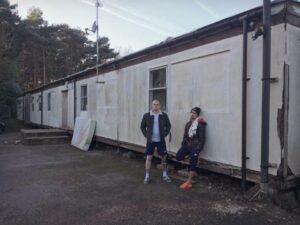
So, moving on from last week’s post where we were looking at the decision to commit to full time Judo training, we shall now look at some of the more prominent elements of the day to day lifestyle and training of the athletes.
Last week we discussed some of the main financial issues facing full time Judo players. Aside from the very occasional player on the higher levels of funding (most of whom still do some sort of work) nearly all athletes I know have to work and earn money to be able to survive and to train full time. Most training structures have to take this into account, that time for work and study is essential. From all the full time centres that I am aware of, most of the time, the training takes place Monday to Friday, in the morning and then later in the evenings. The average training day consists of 3 sessions, sometimes 2 for the older athletes; a strength and conditioning session (30-90 mins) usually followed by a Judo technical session (50-75 mins) in the mornings then, randori in the evening (90 mins). There is an idea that spreading the sessions evenly through the day would permit for more physical rest, which it may, however time for work and study must be allowed for. Also, if doing 3 spread out sessions you are only ever an hour or two away from the next session, mentally most players prefer to get the first two sessions done so that they have a good amount of time off the mat to relax and be more up for the later session.
Strength and conditioning coaches obviously set the gym work which will either be observed by them and/or the Judo coach. Judo technical sessions can vary from skill acquisition, the coach delivering set techniques or, free time for people to work on their own personal preferred techniques or, certain scenarios they need to improve on. A lot of club Judo sessions are a mixture of technical training and randori. Full time randori tends to just exclusively be randori, there is often some uchi-komi and nage-komi towards the start of those sessions but they move pretty quickly into, and stay in, randori. Most athletes are expected to, and do, follow the full programme of training, which is lead by a coach or coaches. This differs with older athletes and other exceptions but largely is completed fully each week by most Judoka.

The first couple of months of full time is a shock to the body, people are doing the same amount of mat time that they were getting in a week beforehand in a day and a half now that they are full time. Training, eating and sleeping was all I did for my first 10 weeks or so after relocating to Camberley, it’s the same for most.
There are a few different types of paid work that players do, one of the most popular being Judo in schools coaching, going in and teaching before or after school Judo classes. These times usually fit in well around training sessions. Some older players set up their own Judo in Schools businesses. Bar, restaurant and security work can be done on some evenings and weekends. I know plenty of players that have had morning cleaning shifts. Some players that are in the military are permitted and supported by the forces to train full time, this is similar to how many Judoka in Europe are able to train so much, with close working relationships between the national Judo associations and the armed forces and police. I have been very fortunate to have been offered a coaching position at Camberley Judo Club, which provides me with a decent part time wage that I’d have to work many more hours to earn the same money were I doing something else; this is similar in some other places, I know some Scottish Judoka have had roles within established clubs and a few in the national (Scottish) institute itself while still competing. I think it is good to see current international players like Emma Reid working in British Judo’s head office.
Similar to a point I made last week, as difficult as full time training can be financially at times, the willingness to do whatever is required leaves many players in good stead after they finish competing. British Masters squad member, Simon Twigg, who has supported me and plenty of others at Camberley, said to me once that what plenty of full time players have to do to get by is somewhat entrepreneurial, it’s no wonder why many do well in business ventures later in life.
Living arrangements differ from place to place. Camberley has an accommodation block next to the dojo where around 20 full time players live, I was in there just shy of 9 years. Some of us older players rent rooms or places together locally now. I believe something is similar at the Welsh Institute of Sport and the national centre at Walsall, onsite accommodation is available or players will source their own in the local area. Plenty of players rent places together to keep the costs down, some coaches have properties that they rent out to athletes.

However you look at it full time Judo leads to longer days. For me, the financial situation and the how much time that has to be given to the sport is what retires athletes most of the time. If we look at professional combat sports it is being shown that many athletes peak in their thirties. It is regularly spoken about most men, particularly British Judo players, peak towards their late twenties and early thirties however, there aren’t many at all that stay in the sport that long, until that point. Again I largely think that has a lot to do with financial support and what the athlete is prepared/asked to do training wise. Does a maturer athlete need to do the same volume of training as a younger athlete? Probably not. From my own observations and experiences the best coaches help athletes navigate those tougher periods. The coaches that get the best out of their players tend to take into account the individual athletes needs, without compromising their own beliefs, in this case giving the older athletes a say in how their own training is structured. The best coaches I know are masters at keeping players in the game, they know you win no medals at all if the athlete walks away from the sport.
I am unsure how all older athletes are trained day to day. It’s also important to remember that maturer athletes have the training history behind them in order to do slightly less training, they have been through those, sometimes gruelling, full time training programmes for years and years. They have learned many of the skills that have been available to them and their bodies are adapted. For me, in non-coved times, Monday to Friday I will do one mat based session per day and will fit 2-4 strength and conditioning sessions around the Judo depending on if an event is coming up. In training I have felt great but competition is the only real tester, time will tell on that one.
I hope that has given the reader somewhat of a basic and clear insight of what the broader day to day routine of a Judo athlete looks like, next time we’ll look at competitions.
Sign up to get my free newsletter, Judo’s Weekly Weigh In, straight to your inbox.

